
The coat of arms of Haarlem is the official symbol of the city of Haarlem. The sword and stars can be found as public decorations throughout the city.

The coat of arms of Haarlem is the official symbol of the city of Haarlem. The sword and stars can be found as public decorations throughout the city.

The coat of arms of Haarlem consists of a red shield with a silver sword with golden handle under a white Jerusalem cross and flanked by 4 white six-pointed stars. Above the shield is the Imperial Crown of Austria under barren branches holding two Damiate bells, all held up by two golden lions standing on the motto of Haarlem. Several heraldic elements have their basis in the history of Haarlem. The motto of Haarlem is Vicit vim virtus (Latin for virtue conquered violence). The barren branches refer to the burned trees in the Haarlemmerhout, which were burned again and again during various sieges, most notably during the siege by the army of Jacqueline, Countess of Hainaut in 1428. Haarlem had taken side with the Cods in the Hook and Cod wars, and thus against Jacoba of Bavaria. The bells refer to the damiaatjes. Two bells were given to the city of Haarlem's St. Bavochurch to commemorate the heroic cutting of the harbour chain during the Siege of Damietta (1218) with a "saw ship", a legendary ship equipped with an iron saw fastened along the bow and front keel. This ship sawed through the harbour chain and allowed the fleet to attack the city, which was a success.

According to local legend, the original shield of Haarlem contained simply the four stars on a red background. As a result of the heroic deeds in Damietta, the Holy Roman Emperor granted Haarlem the usage of a sword and the Patriarch of Jerusalem granted the use of a cross. This story is known as the "Wapenvermeerdering", or "Addition to the Arms". [1] [2] In portrayals of this legend, the emperor is shown with a red beard, since he is supposed to be Emperor Barbarossa.
As Haarlem historians love to point out, Emperor Barbarossa died in 1190 well before the siege of Damietta took place in 1218, so the story shown in the painting is just a Haarlem fantasy of greater knighthood and glory in the Crusades.
During the Hook and Cod wars in the County of Holland in the 15th century, Maximilian I, Holy Roman Emperor supported the bourgeoisie in the cities (Cod) in their fight against the nobility in the countryside (Hook). During these wars Haarlem, like the other cities Dordrecht, Leiden, Amsterdam, and The Hague loaned large amounts of money to Maximilian I. The emperor granted Haarlem and the other cities the right to use his personal imperial crown in their coat of arms, out of gratitude for these loans. In the coat of arms of Haarlem, the Imperial Crown is positioned on top of the escutcheon.
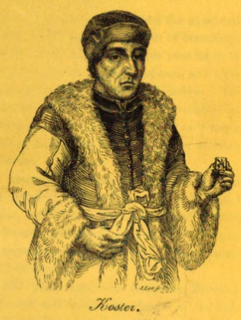
Laurens Janszoon Coster, or Laurens Jansz Koster, is the purported inventor of a printing press from Haarlem. He allegedly invented printing simultaneously with Johannes Gutenberg and was regarded by some in the Netherlands well into the 20th century as having invented printing first.

Haarlem is a city and municipality in the Netherlands. It is the capital of the province of North Holland. Haarlem is situated at the northern edge of the Randstad, one of the most populated metropolitan areas in Europe; it is also part of the Amsterdam metropolitan area. Haarlem had a population of 161,265 in 2019.
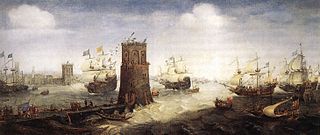
The Fifth Crusade (1217–1221) was a campaign in a series of Crusades by Western Europeans to reacquire Jerusalem and the rest of the Holy Land by first conquering Egypt, ruled by the powerful Ayyubid sultanate, led by al-Adil, brother of Saladin.

The Grote Kerk or St.-Bavokerk is a Reformed Protestant church and former Catholic cathedral located on the central market square in the Dutch city of Haarlem. Another Haarlem church called the Cathedral of Saint Bavo now serves as the main cathedral for the Roman Catholic Diocese of Haarlem-Amsterdam.

The Frans Loenenhofje is a hofje in Haarlem, Netherlands, on the Witte Heren straat.
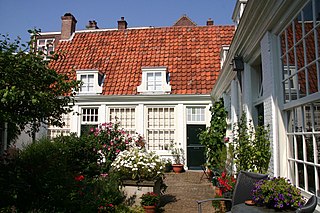
Hofje van Guurtje de Waal is a hofje in Haarlem, Netherlands.

The siege of Haarlem was an episode of the Eighty Years' War. From 11 December 1572 to 13 July 1573 an army of Philip II of Spain laid bloody siege to the city of Haarlem in the Netherlands, whose loyalties had begun wavering during the previous summer. After the naval battle of Haarlemmermeer and the defeat of a land relief force, the starving city surrendered and the garrison was massacred. The resistance nonetheless was taken as an heroic example by the Orangists at the sieges of Alkmaar and Leiden.
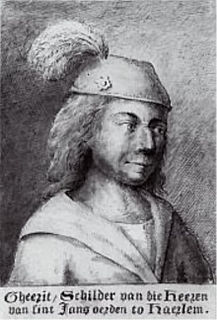
Geertgen tot Sint Jans, also known as Geertgen van Haarlem, Gerrit van Haarlem, Gerrit Gerritsz, Gheertgen, Geerrit, Gheerrit, or any other diminutive form of Gerald, was an Early Netherlandish painter from the northern Low Countries in the Holy Roman Empire. No contemporary documentation of his life has been traced, and the earliest published account of his life and work is from 1604, in Karel van Mander's Schilder-boeck.
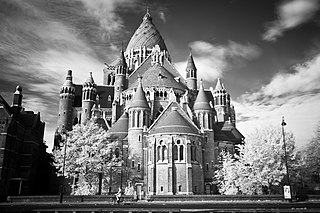
The Cathedral of Saint Bavo is a cathedral in Haarlem, the Netherlands, built by Joseph Cuypers from 1895 to 1930 to replace the former waterstaatskerk in the Jansstraat called the St. Joseph. That church was itself a replacement for the Sint-Bavokerk, that had been converted to Protestantism from Catholicism in 1578. The Cathedral of Saint Bavo now serves as the main cathedral for the Roman Catholic Diocese of Haarlem-Amsterdam. Within the Cathedral, the former sacristy has been converted into a small museum (schatkamer) containing historical artefacts from Haarlem's Catholic past.

The Zuiderhofje is a hofje in Haarlem, Netherlands.

Hendrik Cornelisz Vroom was a Dutch Golden Age painter credited with being the founder of Dutch marine art or seascape painting. Beginning with the "birds-eye" viewpoint of earlier Netherlandish marine art, his later works show a view from lower down, and more realistic depiction of the seas themselves. He is not to be confused with his son and pupil Cornelis Vroom.

The coat of arms of Amsterdam is the official coat of arms symbol of the city of Amsterdam. It consists of a red shield and a black pale with three silver Saint Andrew's Crosses, the Imperial Crown of Austria, two golden lions, and the motto of Amsterdam. Several heraldic elements have their basis in the history of Amsterdam. The crosses and the crown can be found as decorations on different locations in the city.

Cornelis Claesz van Wieringen was a Dutch Golden Age painter.

The Stadsbibliotheek Haarlem is a collective name for all public libraries in the Haarlem area of the Netherlands. The first public library of Haarlem opened in 1921 at the cloisters of the Haarlem City Hall where the academic library had been since 1821. The move to open its doors to the public with a public reading room was only possible after the previous occupant of the downstairs cloisters, the Frans Hals Museum, moved out in 1913 to its present location. As of 2009, there are 6 public libraries and 10 lending points, such as in hospitals.

The Janskerk or St. John's Church is a former church in the Dutch city of Haarlem. Today it houses the North Holland Archives.

The Stedelijk Gymnasium Haarlem or the Latin School of Haarlem is a secondary school in Haarlem, Netherlands. The school was founded in 1389 and is therefore one of the oldest schools in the world. The school offers voorbereidend wetenschappelijk onderwijs exclusively and is an independent gymnasium enrolling 822 students and 95 teachers, for a teacher/student ratio of 8.6.

The Damiaatjes refer to two bells in the St. Bavochurch of Haarlem that ring every night between nine and nine thirty, to signal the closing of the city's gates and commemorate the conquest of the Egyptian city Damietta during the Siege of Damietta (1218). Though Haarlem no longer has a wall around the city, or gates to close, the bells are still rung every evening. Damietta is also mentioned during the Fifth Crusade in 1218/1219, and again during the Seventh crusade in the year 1249. The Haarlem story claims that Haarlem knights and innovative shipbuilders played an important role in the fall of Damietta. Access to the city via the Nile was closed with a large, heavy harbor chain. A Haarlem ship with a saw on the bow was equipped with an iron saw fastened along the bow and front keel. This ship sawed through the Damietta harbour chain and allowed the fleet to attack the city, which was a success. The Damietta story is however contradicted by the eyewitness account of Oliver of Cologne, who led the Dutch fleet, and who never mentioned the heroic actions of the Haarlem knights.

Haerlempjes refer to a specific genre of landscape painting that includes a view of Haarlem. It is used most often to refer to Jacob van Ruisdael's panoramic views of the city, but the term is derived from mentions in Haarlem archives as a type of painting included in household inventories. The diminutive suffix "pje" would denote a small, cabinet-sized painting, but even the largest landscapes may be referred to as Haerlempjes today.
De itinere Frisonum is an eyewitness account written in Latin of the Frisian crusaders' journey from Friesland to Acre during the Fifth Crusade (1217–1218). The narrative was composed by an anonymous participant of the venture who most likely was a member of the clergy. Abbot Emo of Friesland of the Premonstratensian monastery of Bloemhof copied it without alterations into his chronicle. Emo's version is the only surviving copy of the lost original and it is kept in the Library of the University of Groningen in the Netherlands. The narrative is noteworthy for its detailed description of the geography of the lands encountered by the Frisian Crusaders on their journey and the author's perspective on the motivations of his compatriots during the venture. The narrative runs parallel up to the Frisian fleet's arrival to Lisbon with the Rhenish text known as Gesta rhenanorum crusignorum.
The battle of Mansurah took place from 26–28 August 1221 near the Egyptian city of Mansurah and was the final battle in the Fifth Crusade (1217–1221). It pitted the Crusader forces under papal legate Pelagius Galvani and John of Brienne, king of Jerusalem, against the Ayyubid forces of the sultan al-Kamil. The result was a decisive victory for the Egyptians and forced the surrender of the Crusaders and their departure from Egypt.